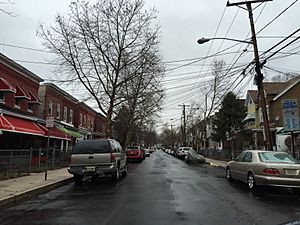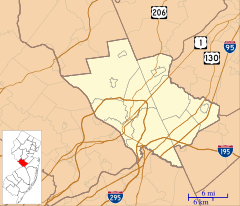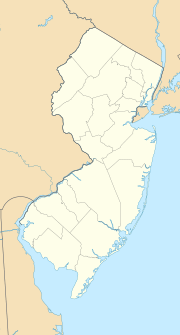North Trenton, New Jersey facts for kids
Quick facts for kids
North Trenton
|
|
|---|---|

Race Street in North Trenton.
|
|
| Country | |
| State | |
| County | Mercer |
| City | Trenton |
North Trenton is a neighborhood located within the city of Trenton in Mercer County, New Jersey. It's a part of Trenton with a long and interesting history.
Contents
How North Trenton Began
The city of Trenton has a history that goes back to the time when America was still a British colony. Trenton was officially recognized as a town on June 3, 1719. After the American Revolution, Trenton became the capital of New Jersey on November 25, 1790. The City of Trenton was officially formed on November 13, 1792.
Over time, other small villages and towns like Chambersburg and Wilbur became part of Trenton. Between 1875 and 1900, Trenton grew a lot, with more people and businesses. In 1901, the city was divided into four main parts called "Wards": North, South, East, and West. Each Ward had its own representatives who worked with the mayor and city council. North Trenton is the area that made up the North Ward.
Buildings and Architecture
At the start of the 1900s, North Trenton was mostly farms, orchards, and large family estates. But after 1910, industries grew and more people moved in. This led to fast development. By 1920, about a quarter of Trenton's population lived in the North Ward.
North Trenton became a popular place for middle-class families and professionals. New neighborhoods were built around parks and green spaces. Shopping areas like the Five Points (or Battle Monument Square) became busy places from the 1920s to the 1960s. Many of the homes and buildings in North Trenton, about 70%, were built between 1919 and 1940. This time is often called the area's "golden age."
During this period, many immigrant groups from southern and eastern Europe moved to North Trenton. A builder from Britain named Samuel Hilton built many of the homes between Brunswick and Princeton Avenues. These homes are known for their special architectural style.
In the 1930s, new housing projects were built between Brunswick Avenue and Perry Street. These were similar to those in New York City. The area around the Trenton Battle Monument, which is the center of North Trenton, still has many old row-houses. These homes were once very fashionable and were built in the Queen Anne and Edwardian styles.
The Trenton Orthopedic Hospital, built in the 1920s, is a great example of Art Deco style. It's located at the corner of Brunswick and Cavell Avenues. This hospital was important for treating polio in the 1930s, 40s, and 50s. It closed in 1970. Sadly, many buildings in the Battle Monument area were left empty in the 1960s and later torn down.
People and Community Life
In the first half of the 20th century, North Trenton was special because it was one of the few areas where people of different backgrounds lived together. While other parts of Trenton were often separated by ethnic groups, North Trenton was a "melting pot." It had a strong middle-class community with many professionals. This mix of people helped build a strong economy and culture for the city.
After World War I, many Polish and Sicilian immigrants moved to North Trenton. At the same time, a thriving African-American middle class also settled there. The northern part of Brunswick Avenue became known as "Little Poland." Italian neighborhoods grew just north of the Battle Monument. Spring Street and Pennington Avenue were at the heart of a lively African-American community. This community was unique for its time because it had so many black professionals. North Trenton was also home to people from Russia, the Middle East, Jewish families, and people of English and Scottish descent. In 1939, a government study even called North Trenton a "model" for how different groups could live and work together successfully.
Famous People and Arts
Many important people lived in North Trenton in the 1930s. These included baseball legend Willie Mays and writer Harriet Lee. Edna Cuthbert, an African-American clothing designer, had a successful studio in North Trenton from 1922 to 1954. She designed clothes for many black celebrities, including singer Lena Horne.
African-American painters, poets, and writers formed the North Trenton Round-Table. This arts group published its own journal and put on plays from the mid-1920s to the early 1950s. The famous actor, singer, and social activist Paul Robeson was involved with the Round Table for many years.
An Italian Theater group called The Bond Street Society started in 1928. There were also several Italian music groups. In 1930, the Fanzini School of Dance opened in North Trenton and operated until the 1950s. Many students from this school went on to become successful dancers on Broadway and in Hollywood. Polish and Yiddish arts and theater groups also thrived in North Trenton from the 1920s to the early 1960s.
Two very famous people were born and grew up in North Trenton:
- Samuel Alito, who became a Justice on the Supreme Court of the United States.
- Norman Schwarzkopf, who was the commander of U.S. forces during the first Gulf War in 1991.
Changes Over Time
By the late 1960s, North Trenton faced many challenges. Middle-class families began to move out, and more people struggling financially moved in. This led to difficult times for the area. The population of the North Ward dropped by over 40% by the 1970s. Many once-busy neighborhoods and business areas became empty. Today, North Trenton is still working to recover from these changes. However, it is still home to a major medical facility, Capital Health System – Fuld Campus.
Important Landmarks
Several important places in North Trenton still show its rich history before the late 1960s:
- The Trenton Battle Monument is a tall granite structure. It looks like Nelson's Column in London. It honors the victory of George Washington's troops over the British during the American Revolutionary War. Many historians believe this battle was a turning point for American independence.
- Our Lady of the Divine Shepherd, built in 1940, was designed by French architect Paul Neas. It was Trenton's only African-American Catholic church until 2002.
- The Polish Falcon Hall, built in 1910, was designed by Frederyk Poszki, a Polish architect. It is still standing and serves as a community center for Polish immigrants. North Trenton still has a large Polish-American neighborhood.
- The historic Shiloh Baptist Church is one of the largest and oldest African American churches in New Jersey, founded in 1888.
- The Lincoln School, built in the 1920s, is a great example of Mediterranean Revival architecture. It was a high school for African-American students from 1929 to 1955 and now functions as a middle school.
Between 1880 and 1950, many Polish immigrants came to North Trenton. In 1919, they established St. Hedwig's Church on Brunswick Avenue. This church is known for its beautiful design and is still a busy Catholic church today. North Trenton is also home to St. Mary's Cathedral, which is the main church for the Catholic Diocese of Trenton. The current cathedral was finished in 1959 after the original one was destroyed by fire in 1956.
From 1899 to 1955, North Trenton had one of the only functioning Islamic mosques in New Jersey, started by immigrants from the Ottoman Empire. A Jewish synagogue also operated in North Trenton from 1899 to 1959. In the 1960s, both the Muslim and Jewish communities moved to the nearby suburbs.
Notable People
- Joe Plumeri (born 1944), who is the Chairman & CEO of Willis Group Holdings and owns the Trenton Thunder baseball team.




